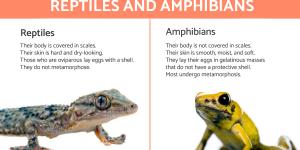Are Turtles Reptiles or Amphibians?


Turtles are one of the most fascinating vertebrates in the animal kingdom. They are particularly well known for their hard shell which provides protection from both predators and the elements. Since not many animals have a carapace like turtles, it can be difficult to think of them as anything but unique. We do know they can have characteristics such as leathery skin, beak-like mouths and colorful markings. These are descriptions we can apply to animals in various animal kingdoms, including mammals and birds. However, their skin and relationship to water means many people wonder are turtles reptiles or amphibians?
AnimalWised answers this question by looking at the classification of turtles. Not only do we find out whether turtles are reptiles or amphibians, but we discover the overall turtle animal classification to know their taxonomic place within the biological kingdom Animalia.
Are turtles reptiles or amphibians?
Turtles are reptiles. We classify living beings for various reasons. In giving animals and other living organisms a taxonomic rank we can organize our understanding of them. Our study of the animal kingdom benefits us in many ways, especially in how we can preserve and care for them. As complicated as this taxonomy can be, putting animals into categories gives us a shorthand to this study and makes it easier for us to understand them.
The animal kingdom is further classified into many categories. These start with some of the largest groups, but are then subdivided until we reach individual species and even certain subspecies. One of the most important ways to distinguish between animal species is whether or not they have a backbone. In this way, we categorize animals as vertebrates and invertebrates.
Reptiles are a type of vertebrate and we know that turtles have a spine. This is part of their skeleton, to which their carapace shell is attached. While their very ancient ancestors lacked this protective appendage, by the Late Triassic period, their evolutionary process led to their anatomy being almost identical to that of current-day turtles.
Among the most important differences that have been known in the fossils we find that they had palatal teeth, which modern species lack. In addition, they did not have the ability to retract their heads into the shell or a structure known as a trochlear pulley, which is involved in jaw closure.
While all animals share the same basic evolutionary beginnings, amphibians and reptiles have a very different ancestry. However, it is believed that reptiles diverged from their amphibian cousins around 300 million years ago.
Why are turtles reptiles?
Turtles are reptiles because they have a series of their own characteristics concurrent with all other animals in the class Reptilia. It is these class-specific characteristics which differentiate turtles from amphibians. For this reason, we can say that turtles are reptiles thanks to the following characteristics:
- Unlike amphibians, reptiles have tough and scaly skin. In addition to this type of skin, turtles present their distinctive and unique shell which is made up of bone and keratin scales on the outer surface. Keratin is the same component present in hair, horns, and claws of other reptile animals, although only turtles have shells.
- As generally occurs in reptiles, turtles lay eggs protected by a shell. Internally, they also have a substance that nourishes the embryo while it develops. These eggs are buried in the sand or soil, then the newborn turtles breathe through lungs after their birth. Amphibians lay their eggs in water or humid areas and the larvae need water to develop.
- Reptiles do not carry out the process of metamorphosis like amphibians do.
- The group of animals known as reptiles has a copulatory organ to provide internal fertilization. Depending on the species, amphibians can carry out internal or external reproduction.
- The mouth muscles of reptiles are much more mechanically efficient, so they have more strength than those of amphibians.
- The circulatory system of turtles and other reptiles is much more efficient than that of amphibians.
- Reptiles have much more developed lungs than amphibians. In addition to pulmonary respiration, aquatic turtles can also breathe through the cloaca. However, when they come to the surface they always breathe through the lungs, while skin respiration is very common in amphibians.
- Turtles have a more developed body structure than amphibians.
- The nervous system of reptiles is considerably more advanced than that of amphibians. Turtles have a larger brain, allowing them learn the paths of a maze similar to how rats do, for example.
You may wonder whether terrapins are reptiles or even if tortoises are reptiles? Since they are all of the reptile order Testudines, terrapins and tortoises are all considered types of turtle.
Learn more about amphibians, you may be interested in learning the difference between frogs and toads.

Turtle animal classification
As stated above, turtles are reptiles that belong to the order Testudines According to the traditional Linnaean classification, the taxonomy of turtles was established as follows:
- Kingdom: Animalia
- Phylum: Chordata
- Superclass: Tetrapoda
- Class: Reptilia
- Order: Testudines
- Suborder: Pleurodira (lateral neck) and Cryptodira (hidden neck)
The cladistic classification establishes the evolutionary relationships of the groups. Based on these established groupings, the believed taxonomic rank of turtles has varied over time. It was first estimated they were closer to the subclass Lepidosauria, a group which includes tuataras, snakes and lizards. However, it was later established that they are more closely related to archosaurs, a group that also includes crocodiles and birds.
Despite this, Testudines is still divided into the two groups mentioned above, Pleurodira and Cryptodira. The difference lies in the way they retract the neck. Pleurodira retract their neck to the side, while Cryptodira do it inside the shell. The reason for these different movements is due to the arrangement of the vertebrae located in the neck of the turtles.
There are also other differences between animals in the order Testudines. Some are related to the articulation of the jaw bones and others linked to the union of the pelvis. In the Cryptodira suborder turtles it is only attached to the shell by means of ligaments, while in Pleurodira the pelvis is inserted with bones.
Finally, let's remember that all types of turtles are reptiles, not amphibians, including aquatic ones. If you want to continue learning, here are some of the types of turtles that exist:
- Side-necked turtles
- Giant tortoises
- Leaf turtles
- Pond or swamp turtles
- Snapping turtles
- Mud turtles
- Leatherback turtle
- Soft shell turtles
- Pig-nosed turtle
- Sea turtles
Now we know that turtles are indeed reptiles, you may want to learn more about other types of reptile. You can do so with our article on the differences between crocodiles and alligators.

If you want to read similar articles to Are Turtles Reptiles or Amphibians?, we recommend you visit our Facts about the animal kingdom category.
- Hickman, C., Roberts, L., & Parson A. (2000). Comprehensive principles of zoology. McGraw Hill Inter-American: Spain.
- Pecor, K. (2003). Testudines Animal Diversity Web. Retrieved from: https://animaldiversity.org/accounts/Testudines/






